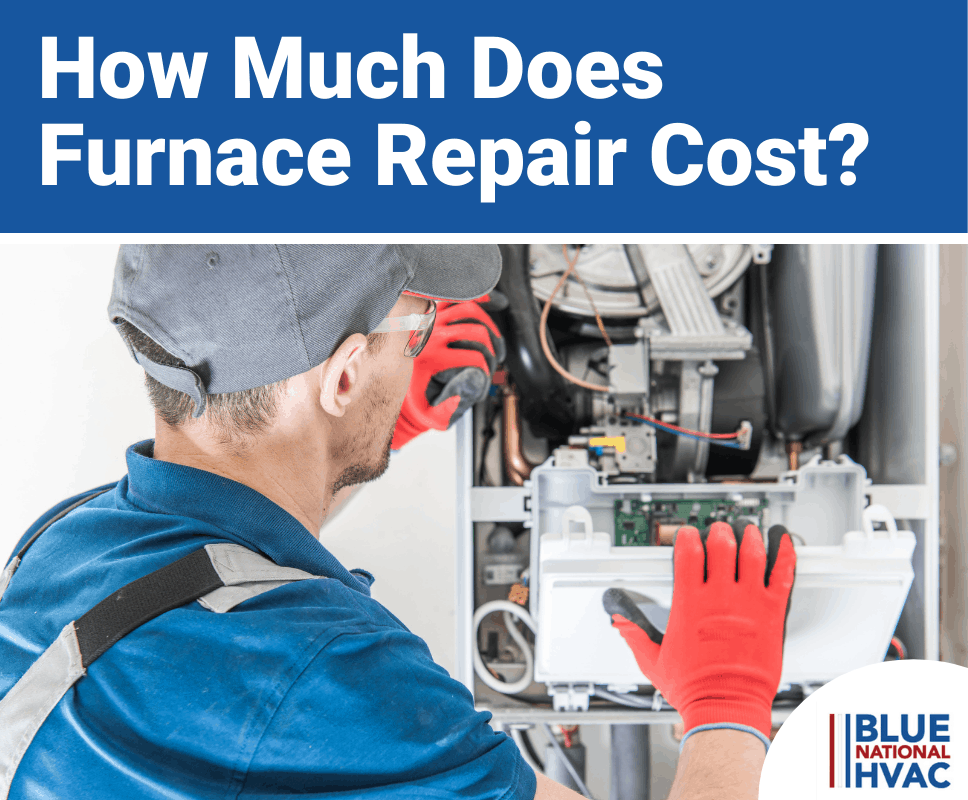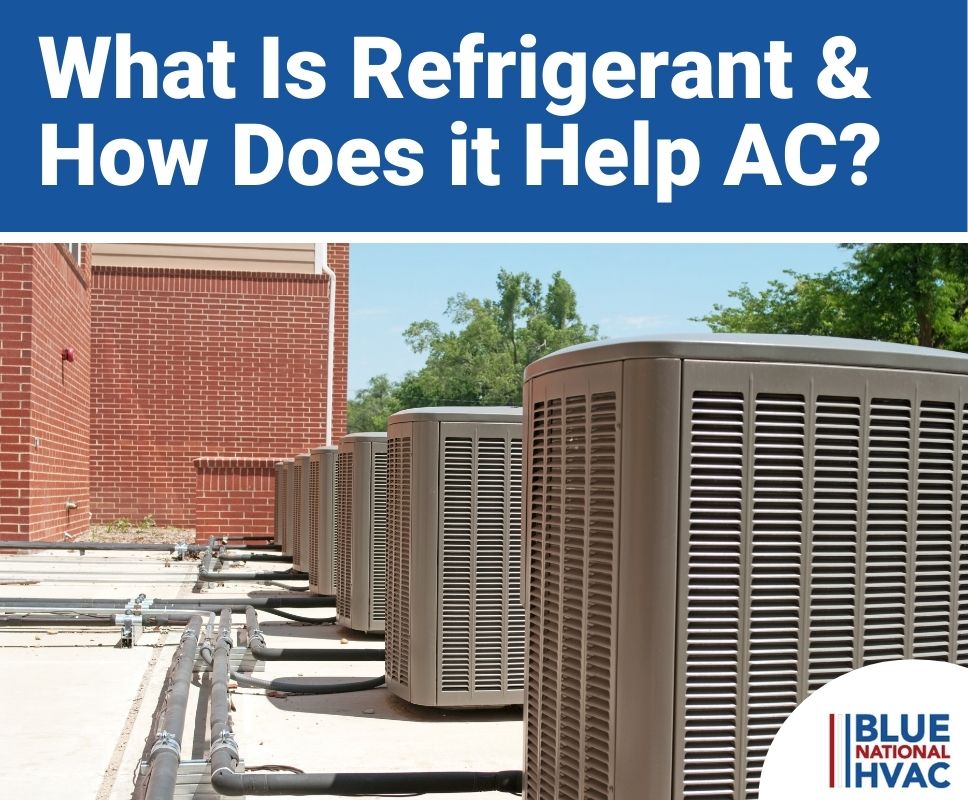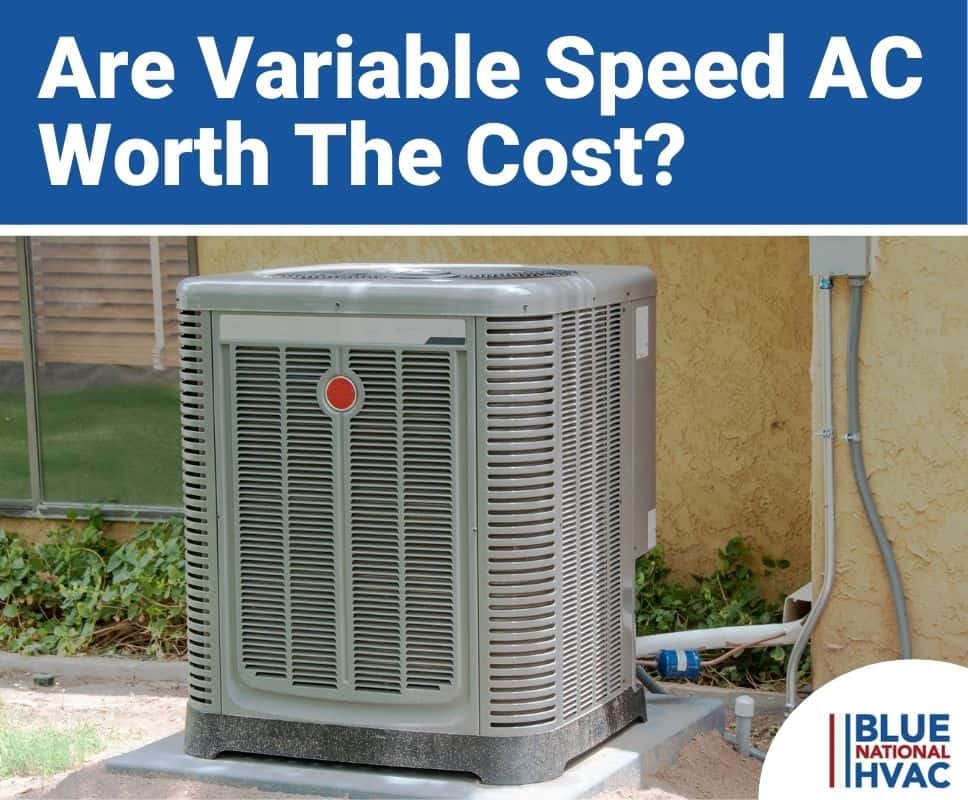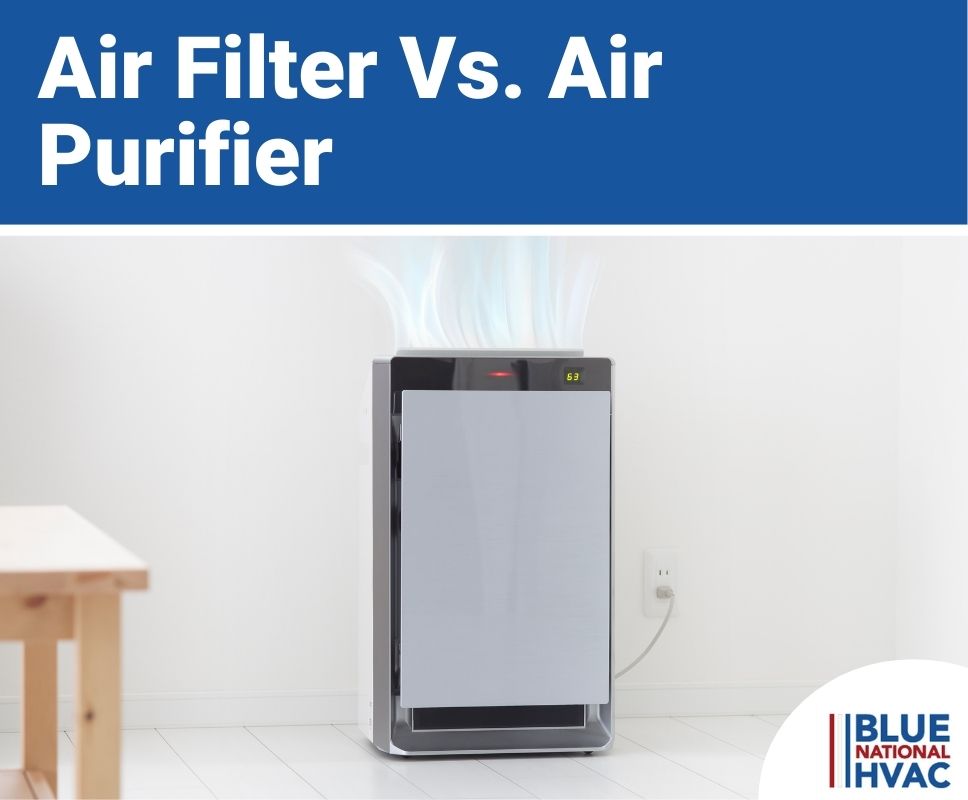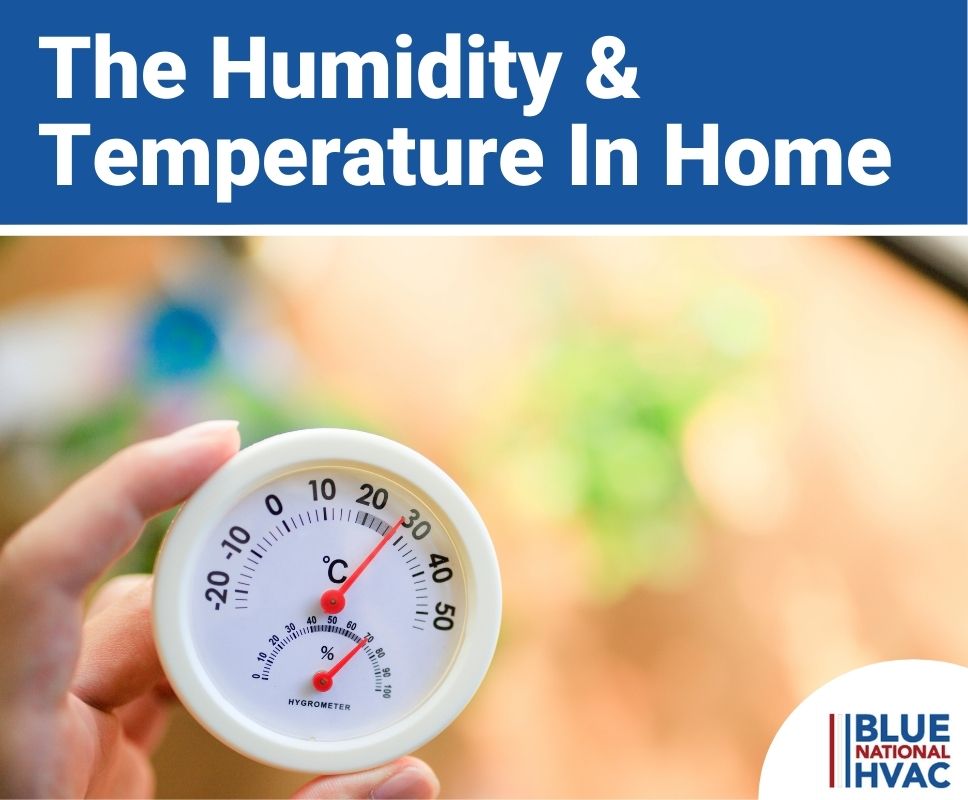Are Furnace Repairs Expensive?
Furnace repair costs vary by the type of repair required. For example, a simple repair like relighting a pilot light on a gas furnace costs under $100, whereas a failed blower motor can cost over a thousand dollars.
Furnace repair costs include the cost of the replacement parts and the labor of the HVAC technician to inspect, diagnose, and repair the issue(s). On average, furnace repair costs span from $50 to $1,700.
Furnace Repair Cost
If you’re like other homeowners in the US, you’re likely wondering how much you’ll be paying to fix your furnace. Here are the average component costs and labor rates to repair common furnace parts and issues:
| Repair Type | Labor (hours) | Total Repair Cost (Labor & Component Costs) |
| Tune-up and routine maintenance – A tune-up and a routine service call are inexpensive and help prevent costly repairs and prevent minor issues from becoming more expensive ones. | 1 hour | $100 to $200 |
| Dirty Filter – A filter clogged with dust will prevent proper airflow to your rooms and limit the heating. Cleaning or replacing yourself is a DIY option for the homeowner. An HVAC technician will charge their labor rate to clean/replace your filter, so it is best done yourself. | 1 hour | $100 to $200 |
| Flame sensor & thermocouple -cleaning the flame sensor or the thermocouple is necessary if it is reading inaccurately due to being charred or covered in a thick layer of soot. | 1 hour | $100 to $200 |
| Flame sensor & thermocouple cleaning – replacing flame sensors is done as preventative maintenance if your furnace is over ten years old or fails. | 1 hour | $300 to $450 |
| Thermostat – when the thermostat starts glitching or stops working, a replacement is required. | 1 hour | $70 to $750 (depending on model) |
| Transformer – the transformer converts incoming electricity to a usable voltage, and when it goes bad a replacing it is a necessity | 2 hours | $100 to $200 |
| Control board & circuit board – when the control board shorts out, it is recommended to replace the entire board to ensure proper control. | 2 to 3 hours | $250 to $700 |
| Flue pipe – the flue pipe is critical to the safety of your home as it extracts carbon monoxide and leftover combustion gas from your burner to outside your home. The prices vary on length on the installation difficulty. | 2 hours | $450 to $1,000 |
| Heat exchanger – The heat exchanger transfers the heat from your burner to the air, providing heat to your home. If it fails, replacing it is a complex process as it requires a complete furnace disassembly. | 2 to 5 hours | $900 to $1,600 |
| Relay switch – a relay replacement is simple and quick; a failed one would prevent the furnace from turning on. | 1 hour | $100 to $200 |
| Ignitor – the ignitor lights the gas in your furnace to provide heat. If your furnace is older than ten years, consider replacing the ignitor as preventative maintenance. | 1 to 1.5 hours | $175 to $300 |
| Capacitor – the capacitor energizes the furnaces and is a quick and straightforward replacement if it goes bad. | 1 hour | $100 to $250 |
| Gas valve – If the valve goes bad, the replacement takes a bit of time as the gas supply must be turned off. | 2 to 3 hours | $350 to $800 |
| Gas valve & burner – gas valves should be cleaned routinely, at least every two years. | 1 hour | $175 to $450 |
| Draft motor – the draft motor pulls combustion gases, including carbon monoxide, and forces through the flue pipe to the outdoors. It is essential to repair a draft inducer motor right away as carbon monoxide is deadly. | 1 to 2 hours | $600 to $750 |
| Blower motor – The blower motor supply the heated air to the rooms in your house. Repair costs vary based on the specific issues, the brand of motor, and the local labor rate. | 1 to 2 hours | $150 to $500 |
| Blower motor – If the motor had a critical failure, a replacement would be necessary. Sometimes the blower is covered under an extended warranty, meaning you’ll only pay for the labor. | 1 to 2 hours | $400 to $1,400 |
| Pilot light – a faulty pilot light could prevent the furnace from igniting. A failed pilot light is uncommon but not a complex replacement procedure. | 1 to 2 hours | $80 to $200 |
| Fan limit switch – when the fan limit switch malfunctions or fails, it could cause the blower to run continuously, destroying the motor. A swift replacement will prevent further damage to the heating system. | 1 hour | $50 to $150 |
5 Common Furnace Repairs
No furnace issue is the same, and they frequently pop up at the most inopportune times possible, like the middle of winter. If your furnace is not heating your home, give our HVAC experts a call to schedule a furnace repair service right away.
While your furnace problems can be any of the above issues, the most common furnace repairs are as follows.
Thermostat ($70 to $750)
A broken thermostat either does not turn your furnace on at all, or it can malfunction and misread the temperature in your home.
Since the thermostat is the “brains” of your HVAC system when it fails, your furnace (and air conditioner) will not correctly heat (or cool) your home. As such, if the thermostat fails or malfunctions, it should be replaced right away. The furnace needs the thermostat to run.
A thermostat replacement can costs as low as $20 for a simple button-controlled thermostat and up to $250 for a smart thermostat. Smart thermostats can be controlled through a touchscreen, a mobile app, or with the help of a voice assistant like Siri (Apple), Alexa (Amazon), or Google Assistant.
Installation and labor to replace a failed thermostat has an average cost of $50 to $500. It varies depending on the geographic area’s labor rate and the HVAC contractor.
Blower Motor ($150 to $1,400)
The blower motor in your furnace drives the unit’s fan, which pushes the air through your duct and out of your supply vents. Blower motors typically fail when they overheat, get saturated with excessive moisture, or become clogged with dirt and debris.
When dust, dirt, and moisture caught in the blower motor, it will cause the mechanical components, like the bearings, to wear down faster. Additionally, excess moisture can cause electrical shortages, which could fry the motor.
Repairing the blower motor can cost on average $150 to $400, and a motor replacement costs on average from $400 to $1,400. Blower motor prices vary based on the brand and the speed. However, many manufacturers, such as Trane, Lennox, and Carrier, have extended warranties on the blower motor, meaning if yours fails, you’ll pay $0 for a new blower motor. If you’re unsure, ask one of our HVAC contractors to verify the warranty of your system.
Residential blower motors are made in two different speed types:
- Single-speed blower motors – Single speed units move air at just a single speed and only run on or off
- Variable-speed blower motors – variable speed units
Failed Fan Limit Switch ($50 to $150)
The fan limit switch tells controls when the fan turns on and off. When the limit switch breaks, it can make your fan unable to turn on. Alternatively, it can cause the fan to run continuously, which can burn out the blower motor.
If you notice the fan running forever, get it checked out before it destroys the motor.
A failed limit switch is an easy and low-cost repair, have a price range between $50 to $150 on average.
Flame Sensor ($300 to $450)
The flame sensor in natural gas furnaces is a safety mechanism that ensures the gas in your furnace is lit. When the flame sensor detects a flame, it sends an electrical output (microamps) to the furnace control board.
If the igniter does not ignite the gas, the flame sensor won’t send a signal to the furnace control board. In this case, the furnace will not turn on.
If the flame sensor is dirty, it could incorrectly tell the furnace control board that there is no flame. The pricing is between $100 to $200 to get your flame sensor professionally cleaned.
If the flame sensor fails, the average cost is between $300 to $450 to have it replaced.
Circuit Board ($250 to $700)
The circuit board of your furnace controls when the furnace turns on and off. It also controls the burners and the igniter.
Without an operational control board, your furnace will be dead in the water. A replacement control board and installation has an average price range of $250 to $700. They can rarely be repaired.
Should You Repair Or Replace Your Furnace?
When your furnace fails, it is indeed troublesome. If it putters out in the dead of winter, you have to get it repaired quickly, or you’ll have to make a plan on how to keep your family warm and your pipes from freezing. After you contact a furnace repair specialist, you might be left at an unfamiliar crossroad with two options – repairing or replacing your furnace.
If you find yourself contemplating a system repair or furnace replacement, you’ll want to consider a multitude of cost factors to help you make the best decision. One of our experienced HVAC technicians could talk through the pros and cons of each, but ultimately the decision is up to you.
A new unit and furnace installation costs between $1,700 to $6,500 depending on the type of furnace, brand, model, and unit efficiency.
Here are the crucial factors to weigh in your decision to replace or repair:
The Age of the Furnace
If your furnace is 15 years or older and has broken down, requiring a costly repair, most experts recommend a replacement. If your furnace meets these criteria and has required additional repairs in the recent past, you should strongly consider replacing it.
Furnaces 15 years and older are more likely to fail again soon after the repairs are completed, and in the end, multiple repairs over many months to a few years may end up costing you more than a new furnace altogether.
You can expect a 15-30 year life of your furnace; this is the national average and might be better for certain brands.
The Cost of Repairs
When your furnace requires an expensive repair, it might be more economical in the long run to just buy a new one. Since older units tend to require more repairs, it could lead to a pile of repair bills that are higher than the cost of a new furnace (or close to it)!
When the cost to repair your furnace is above half the price of a new system, it is recommended that you purchase a new one instead. This method has been shown to save money over a longer period, plus you get a new furnace and reduce your worries of losing heat!
When You Plan to Move
The length of time you plan to live in your home could be a factor in your decision to repair or replace your air conditioner.
For example, if you plan to move in 6 months to a year, you might opt for a repair and let the next owners update the furnace to their liking. Alternatively, you might replace the furnace, along with some other home improvement updates, before you list your home for sale to increase the resale value.
Lastly, if you plan to live in your current home for 10-15 years or more, replacing the furnace wouldn’t be a bad decision.
Carbon Monoxide
Carbon monoxide (CO) is a dangerous, odorless gas. Too much CO inhalation can be fatal, which is why it is vital to install CO monitors in your home and test them each month.
If your furnace has failed in such a way that it is pumping excess CO into your home, replacing the furnace should be your immediate solution. Your safety should be of the utmost importance when making this decision.
Besides your carbon monoxide alarms going off, carbon monoxide could have the following side effects on your home:
- Rusting and corrosion on pipes or metal near your furnace
- Soot marks or charring on around your furnace
- A yellow flame on your pilot light, it should be a blue flame
- Condensation on the windows and walls
Additionally, if you and others in your home suddenly have these symptoms, you could have a carbon monoxide leak:
- Nausea
- Forgetfulness
- Disorientation
- Body aches
- General unwellness similar to the flu
If you notice any of these signs or symptoms of carbon monoxide in your home, seek the outdoors immediately and call the fire department.
Increased Energy Bills and Less Effectiveness
Paying more money for less effective heating is never a good thing. If you are starting to notice a significant increase in your heating bill compared to previous years combined with your home often being too cold, it’s time to consider a replacement.
How Can Future Repairs Be Avoided?
Completing preventive maintenance on your HVAC system will extend the lifespan of your furnace and less frequent repairs. If you never have the necessary regular maintenance completed, your furnace will suffer. It will struggle to operate, and components will break down one by one.
Doing the following preventative furnace maintenance checks and repairs will fend off costly repairs for years, saving you money and keeping your home comfortable.
Replace or Clean Air Filters
Cleaning the air filters provide more efficient airflow and better heating to the home. Additionally, they improve indoor air quality, which makes the home more comfortable for the occupants. If you’re sneezing and getting allergies in your home, make sure you check your air filter routinely.
Clear Supply Vents of Obstructions
When the furnace can provide unrestricted hot airflow to your home, it runs at optimal efficiency. If you close off more than two to three supply vents in your home, that will restrict airflow and put stress on the blower.
Ensure almost every supply vent is fully open and that there is no furniture or other obstructions over the vents.
Clean the Flame Sensors
The flame sensor is a safety mechanism that signals the furnace control board the gas is lit and burning. When the flame sensor gets filthy with soot, it can misidentify a lack of flames.
When that happens, the furnace will not turn on. Since it thinks there are no flames, it stops to prevent the pumping of natural gas throughout your home.
Check the Flue
The flue pipe transports excess combustion gases and carbon monoxide out of your home. The flue pipe should be checked routinely for gaps, holes, and dents. Any leaks should be promptly addressed and fixed.
Clean the Furnace
Furnaces move a lot of air over the heating season. Along with the air, it also pulls in dust, pet hair, and other dirt into the ductwork. The air filter collects most of this dirt, but some of it does get through to other components.
Vacuuming out the burner and blower cavities and the blower blades when the furnace is off will help prevent these components from failing.
When To Call An HVAC Specialist
When you need your furnace repaired, you should rely on a certified repair specialist to get the job done. A DIY repair attempt by a homeowner can further damage the furnace, or worse, cause a catastrophic carbon monoxide or gas leak. If you have no experience in HVAC repairs, get in touch with us.

Call our HVAC experts today to schedule a repair and learn about our preventative maintenance service plans for your air conditioning and heating system.

